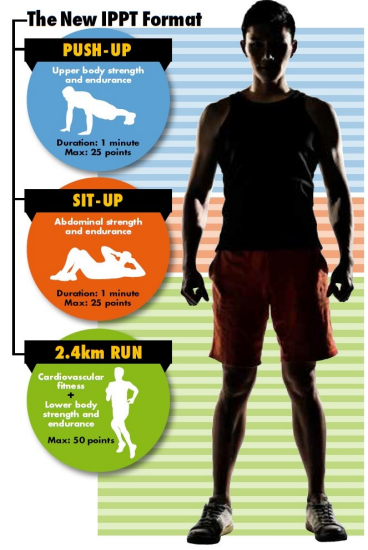OPS & TRAINING
ALL-NEW IPPT
01 Sep 2014

What you need to know about the changes.
There comes a time each year when all Singaporean men must jump, crunch, sprint, pull and run in the name of defence.
From April next year, this will be reduced to pump, crunch and run as the Individual Physical Proficiency Test (IPPT) is simplified to a three-station format (instead of five).
If you do not already know, the new three-station IPPT consists of push-ups (new), sit-ups and a 2.4km run.
Speaking to local media on the changes to IPPT on 23 Jul, Chief of Army Major-General (MG) Perry Lim said: "We will introduce a simpler IPPT format with fewer stations so that our servicemen can train for IPPT on their own without the need for specialised equipment."
The transition will be gradual, he added. "We are prepared to give NSmen (Operationally Ready National Servicemen) an option to do the existing five-station format or the new format for one to two years after April next year."
The goal is to get everyone more involved in keeping fit, he noted. "We want our NSmen to take ownership of their physical fitness."
Easier to train for
For NSmen like Captain (CPT) (NS) Lim Seow Lye, the simplified IPPT format makes it easier for him to train for the annual test. "I can easily train for the two new static stations at home," he said. To train for the old five-station IPPT, some equipment, such as pull-up bars, is needed.
Like many NSmen, the 34-year-old juggles work, family and NS commitments. CPT (NS) Lim is a manager at Certis Cisco and serves in a National Service (NS) Guards unit.
Being able to train for his IPPT easily at home is a benefit to him. "That way, my wife won't nag that I leave her alone to manage the kid and housework!" he laughed.
Simpler scoring system
The scoring system will also change to a simpler format. Soldiers will earn points for their performance in each of the three stations. And the entire IPPT will be scored upon a maximum of 100 points.
Explained Minister for Defence Dr Ng Eng Hen in a Facebook post on 23 Jul: "This way, soldiers can make up through more sit-ups, if they are weak in push-ups and running, or vice versa. There's a limit to how much you can make up, but I like this counting system because it encourages NSmen to max out on each station and it plays to the individual's strengths."
The 2.4km run carries the heaviest weightage. Soldiers can potentially score up to 50 points for the run. Push-ups and sit-ups carry a maximum of 25 points each.
For NSmen the magic number is 51. That's the number of points they need to pass the new IPPT format. For Full-time National Servicemen and Regulars, the bar is set higher at 61 points. They are held to a higher passing standard because fitness training is incorporated into their work and training routine.
Fewer IPPT stations do not mean a lowering of the bar. For example, to just meet the passing grade, a typical 30-year-old NSman who is weak in the 2.4km run will still need to clock a run-timing of 13min 50s (for 25 points), 27 sit-ups in a minute (for 13 points) and 21 push-ups in a minute (for another 13 points).
Said Colonel (COL) (NS) Bervyn Lee, commander of an NS brigade: "To do well in the three stations still requires effort. (And) we shouldn t allow three or five stations to define our fitness My fitness is mine and mine alone to take care of."
COL (NS) Lee holds a PhD in Sports and Exercise Psychology, and is a member of the SAF fitness advisory board.
"Our servicemen will still need to train to pass IPPT. To achieve Gold and Silver will be just as challenging as before," said MG Lim.
Total fitness
The new IPPT format was designed as part of the SAF's holistic fitness regime. Explaining the move, MG Lim said: "Over the past few years, we have implemented a revised combat fitness training and test regime for our soldiers."
Other military forces have also moved away from the older, more onerous physical fitness test formats. The United Kingdom military puts its soldiers through a similar test of push-ups, sit-ups and a beep-test. A beep-test is a series of short sprints in time to recorded "beeps" (hence the name) which measures aerobic fitness like the 2.4km run. The SAF builds up the combat fitness of its soldiers through the Standard Obstacle Course (SOC), Vocation Obstacle Course (VOC) and Vocation-Related Exercises (VREs). The VOC and VREs were implemented in September 2010.
"The VREs are developed in line with sports science principles of progressive training and specificity, targeting muscle groups relevant for the combat task," said Dr Roger Tian, a sports physician from Changi General Hospital, at the launch of the redesigned SOC.
Regular route marches and field exercises also help develop soldiers' combat fitness.
"Having implemented an effective combat fitness regime, we think it is timely for us to review our IPPT, which is a test of physical fitness," said MG Lim.
Tighter age-bands
Age categories have also been re-looked and shortened. Instead of five-year bands, servicemen will now be held to different physical fitness standards every three years. The new age category system is more sensitive to the effects of age on physical fitness, said MG Lim.
For example, an NSman within the 34-to-36 age group will need to perform 35 push-ups in a minute for 20 points, 35 sit-ups in a minute for 20 points and run 2.4km in 10min 40s for 41 points. This gives him a total of 81 points which qualifies him for the IPPT Gold award.
Drop one age-band, and the NSman will have to do 36 push-ups in a minute, 36 sit-ups in the same time and run the 2.4km distance in 10min 30s.
For elite units in the SAF such as the Commandos, naval divers and Guardsmen, the bar for IPPT Gold is a minimum of 85 points.
More time for IPPT
From 1 Sep, NSmen will have a year to clear their IPPT, IPPT Preparatory Training (IPT) and Remedial Training (RT) requirements. The current system gives NSmen nine months to clear IPPT and IPT, then a further three months to clear RT if needed.
Under the new system, soldiers must attempt and pass the IPPT within 12 months of their birthdays. NSmen can also opt for a 10-session IPT programme.
The extra time is welcome for NSmen like Corporal (NS) Azfar Bin Hashim. "Having a 12-month window on top of the simpler IPPT format really means that NSmen have no excuse to fail," said the 30-year-old writer, who served NS as a Close Combat Instructor with the Army Fitness Centre.
The award money for doing well in IPPT has also been raised by $100 across the board. Achieving the Gold standard now nets NSmen a $500 cash award (compared to $400 under the old system) and a Pass with incentive comes with a $200 award.
More help
IPT and RT as NSmen know it will also change from 1 Sep. Training will move away from IPPT-centric exercises and include more varied workouts such as high-intensity circuit training and sports-fitness classes like kick-boxing.
The IPT and RT class sizes will also be reduced from 50 to 30, so that fitness trainers can better coach each participant. Training sessions will also be shortened to about 75 minutes, as compared to two hours. To provide more convenience for NSmen, the Fitness Conditioning Centres where IPT and RT are conducted will extend their opening hours and offer more sessions on weekday nights and weekends.
Currently there are IPT sessions available every weeknight, with the exception of Fridays. On weekends there is one session on Saturdays and two on Sundays.
Another change: NSmen will be able to book IPT and RT sessions on the same day. Currently NSmen must book their sessions at least 24 hours in advance.
"I think the SAF has done its best to help and encourage NSmen to keep in peak fitness. Seriously, kudos to the SAF," said Lieutenant (NS) Gerald Tan, a Business Development Manager who serves as a Motor Transport Officer in the 428th Battalion, Singapore Armoured Regiment.
He had one suggestion: "Maybe we can keep the old IPPT for NSFs and NSmen can do the new (three-station) IPPT."
He's probably not the most popular NSman with the NSF population right now.
For more information on the new IPPT format and fitness system, check out mindef.sg/newippt1!
"We will introduce a simpler IPPT format with fewer stations so that our servicemen can train for IPPT on their own without the need for specialised equipment."
- Chief of army, MG Lim
The new IPPT format simpler, yet effective
Fitness is an important element of soldiering. The SAF constantly reviews its training system, including physical training regimes and physical fitness tests, to ensure that they are relevant and effective. Starting from 1 Sep 2014, the SAF will launch a pilot implementation of a new and simpler Individual Physical Proficiency Test (IPPT) format, which will be accompanied by a new scoring system. This simpler test format will further motivate our servicemen to take greater ownership of their fitness.
New Scoring System
The SAF will introduce a new scoring system to accompany the new IPPT format.
Servicemen will be allocated points for their performance in each of the three stations. Based on a maximum of 100 points, the award type is determined by the total score from the 3 stations as opposed to a passing score for each station. However, servicemen must attain a minimum score at each station. This new scoring system will encourage servicemen to do their best for each of the stations.
Active servicemen will continue to be held to a higher passing standard because fitness training is part of their work and training routine. The elite combat troops, Commando, Diver, and Guards vocationalists will continue to be held to a higher Gold standard.
ALSO READ IN OPS & TRAINING

Exercise Wallaby 2025: To see better, shoot faster
31 Oct 2025
The SAF focuses on complex strike missions and multi-domain integration in Exercise Wallaby 2025, the 35th edition of its largest unilateral overseas exercise.

Ex Wallaby 25 – Greater Integration and Complexity
25 Oct 2025
The 35th edition of the SAF’s largest unilateral overseas exercise is an opportunity for expanded scale and deeper integration towards an effective, networked fighting force.

Ex Forging Sabre ramps up use of unmanned assets in integrated strike operations
12 Sep 2025
In this 10th edition of Exercise Forging Sabre, the SAF sharpened its cutting edge for the dynamic modern battlefield, with expanded integration between manned and unmanned platforms.






